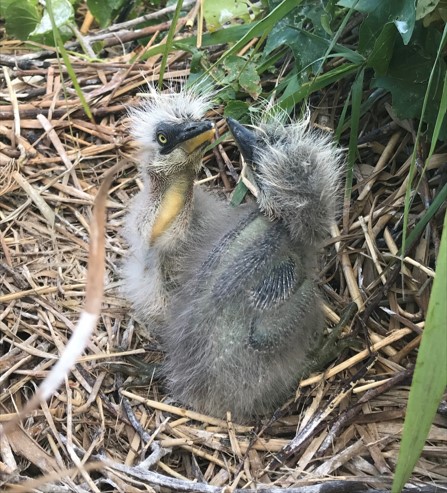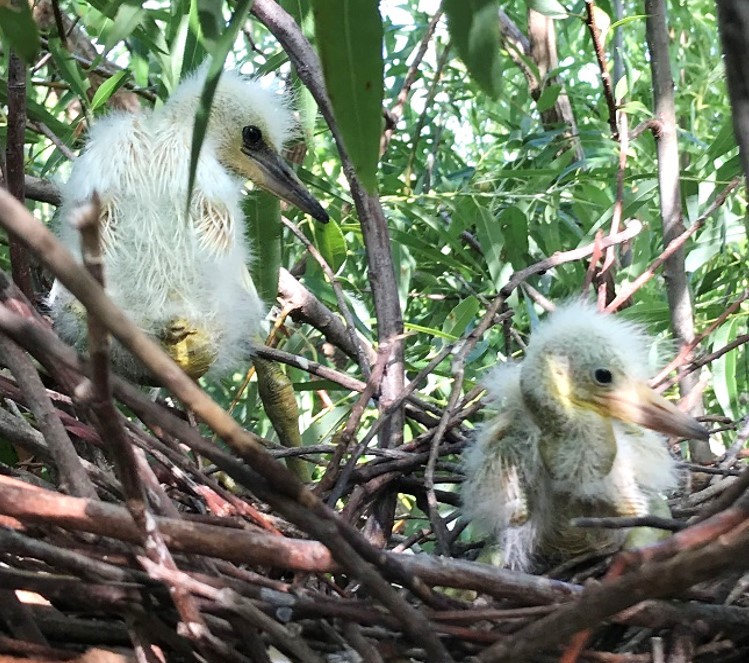 Overview
OverviewWading birds are monitored globally as indicators of wetland health and ecosystem changes because they are sensitive to hydrologic fluctuations and occupy a top trophic level position. In Florida, wading bird population abundances and productivity serve as indices of habitat quality and wetland restoration progress throughout the Greater Everglades ecosystem. Effectively monitoring wading bird populations and colony dynamics is essential for evaluating the progress of the Comprehensive Everglades Restoration Plan (CERP). My study aims to improve the efficiency of wading bird monitoring and elucidate habitat use patterns in a highly modified wetland ecosystem.
 My first objective is to improve the efficiency of wading bird monitoring by testing the use of autonomous recording units (ARUs) as alternatives to traditional survey methods for estimating species composition and abundance in wading bird colonies. The use of ARUs to monitor vocal wildlife is increasing, as they provide cost-effective, less invasive, and standardized methods for sampling wildlife across large spatial and temporal scales. However, these methods have not been applied to nestlings or wading bird species. I am deploying ARUs in colonies of Great Egrets (Ardea alba), Snowy Egrets (Egretta thula), and Tricolored Herons (E. tricolor) on Lake Okeechobee to measure vocal activity rates (VAR) of nestlings during the breeding season.
My first objective is to improve the efficiency of wading bird monitoring by testing the use of autonomous recording units (ARUs) as alternatives to traditional survey methods for estimating species composition and abundance in wading bird colonies. The use of ARUs to monitor vocal wildlife is increasing, as they provide cost-effective, less invasive, and standardized methods for sampling wildlife across large spatial and temporal scales. However, these methods have not been applied to nestlings or wading bird species. I am deploying ARUs in colonies of Great Egrets (Ardea alba), Snowy Egrets (Egretta thula), and Tricolored Herons (E. tricolor) on Lake Okeechobee to measure vocal activity rates (VAR) of nestlings during the breeding season.
First, I will test whether nestling vocalizations correlate with provisioning rates in wading bird colonies. Nestling provisioning by adult birds is often measured by direct observation or by cameras that capture images of adults feeding nestlings. However, observing nests is time-intensive and cameras can only focus on a single nest at a time, limiting the scope of detection. Placing audio recorders in the colonies will improve monitoring efforts by detecting nestling begging calls from multiple, nearby nests, maximizing the number of provisioning rates measured at one time. To test this method, I mount time-lapse cameras and ARUs near the same nests in wading bird colonies to compare the timing of begging calls with visual confirmation of provisioning from camera images. Because colonies serve as our unit of study, detecting call rates from an aggregation of nests will provide a more accurate representation of provisioning rates throughout the colony.
 I will also analyze the relationship between VAR (# calls/min) and nest density in wading bird colonies. An underlying assumption of acoustic monitoring is that vocal activity rates positively correlate avian abundance. I will quantify this relationship by measuring daily VAR in a colony with a known number of nests and will use this relationship to develop an index for estimating nest abundances based on acoustic activity. This method will be particularly applicable to species nesting in areas difficult for researchers to access, as ARU battery and storage capacity allows for long-duration monitoring with less time and effort spent in the field.
I will also analyze the relationship between VAR (# calls/min) and nest density in wading bird colonies. An underlying assumption of acoustic monitoring is that vocal activity rates positively correlate avian abundance. I will quantify this relationship by measuring daily VAR in a colony with a known number of nests and will use this relationship to develop an index for estimating nest abundances based on acoustic activity. This method will be particularly applicable to species nesting in areas difficult for researchers to access, as ARU battery and storage capacity allows for long-duration monitoring with less time and effort spent in the field.

 My second objective focuses on wading bird nesting patterns in the Greater Everglades ecosystem. In south Florida, the decline of wetland habitat has forced wading birds to nest outside of core Everglades colony sites, indicating that wading birds may rely on alternate habitats (i.e., habitats that provide resources for species outside of their core habitat or range) for breeding and foraging (Figure 1). I am testing for use of alternate habitats by wading birds in south Florida by comparing annual fluctuations in the nesting abundances of Great Egrets, Snowy Egrets, White Ibis (Eudocimus albus), and Wood Storks (Mycteria americana) between core nesting regions and alternate nesting regions (Figure 2). Using the Kendall rank correlation coefficient, I will test whether nest abundance increases in alternate habitats when abundance decreases in core habitats and vice versa. Comparisons of annual nest abundances in core and alternate habitats will elucidate patterns of habitat use across the Greater Everglades ecosystem, revealing the relative importance of regional nesting areas and allowing for management of important habitats in a highly modified wetland ecosystem.
My second objective focuses on wading bird nesting patterns in the Greater Everglades ecosystem. In south Florida, the decline of wetland habitat has forced wading birds to nest outside of core Everglades colony sites, indicating that wading birds may rely on alternate habitats (i.e., habitats that provide resources for species outside of their core habitat or range) for breeding and foraging (Figure 1). I am testing for use of alternate habitats by wading birds in south Florida by comparing annual fluctuations in the nesting abundances of Great Egrets, Snowy Egrets, White Ibis (Eudocimus albus), and Wood Storks (Mycteria americana) between core nesting regions and alternate nesting regions (Figure 2). Using the Kendall rank correlation coefficient, I will test whether nest abundance increases in alternate habitats when abundance decreases in core habitats and vice versa. Comparisons of annual nest abundances in core and alternate habitats will elucidate patterns of habitat use across the Greater Everglades ecosystem, revealing the relative importance of regional nesting areas and allowing for management of important habitats in a highly modified wetland ecosystem.